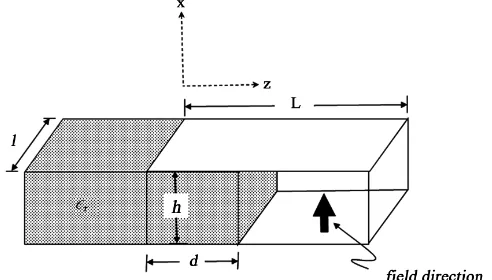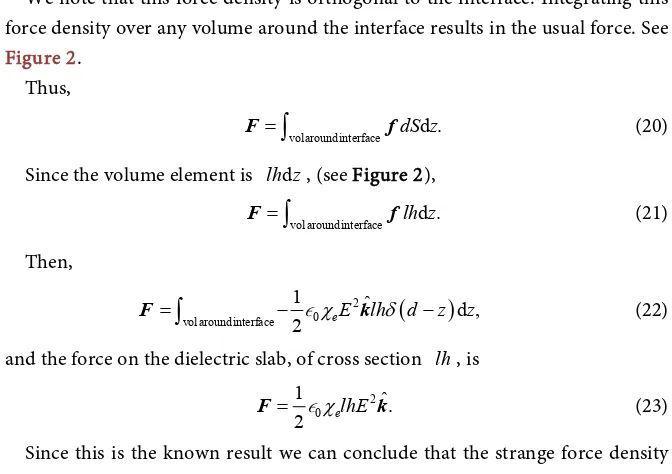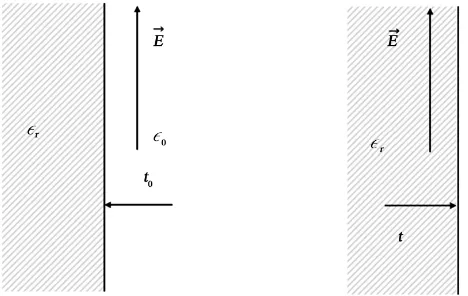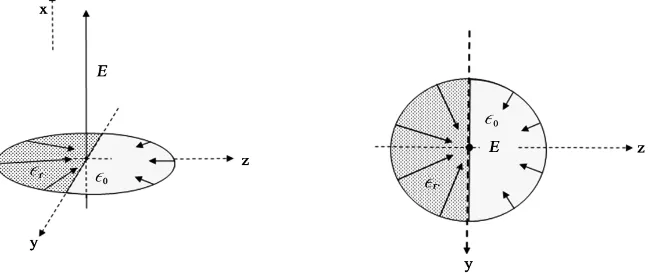ISSN Print: 1942-0730
DOI: 10.4236/jemaa.2018.107010 Jul. 30, 2018 131 Journal of Electromagnetic Analysis and Applications
How Does Arise the Force on a Dielectric Slab in
a Parallel Plate Capacitor?
Ignacio Campos-Flores
1, José-Luis Jiménez-Ramírez
1*, José-Antonio-Eduardo Roa-Neri
21Departamento de Física, Facultad de Ciencias, Universidad Nacional Autónoma de México, Mexico City, Mexico
2Área de Física Teórica y Materia Condensada, División de Ciencias Básicas e Ingeniería, Universidad Autónoma Metropolitana
Unidad Azcapotzalco, Mexico City, Mexico
Abstract
We address the problem of the force exerted on a dielectric slab partially in-troduced into a charged parallel plate capacitor. This elementary problem is usually solved calculating this force as the gradient of an energy and attribut-ing its origin to the action of the frattribut-ingattribut-ing field outside the capacitor on the dipoles of the dielectric slab. By applying Maxwell’s theory of electromagnetic stresses, we show that this force acts at the interface dielectric-vacuum and originates from the action of these stresses. This approach permits to obtain the force as a volume integration of a force density, or as a surface integral of a stress tensor. This force density and the stress tensor are part of a momentum balance equation derived from Maxwell’s equations.
Keywords
Classical Electromagnetism, Maxwell Equations, Electrostatics, Maxwell Balance Equation, Maxwell Stress Tensor
1. Introduction
One of the simplest interactions of electromagnetic fields with matter is the in-teraction of the electrostatic field of a parallel plate capacitor with a dielectric slab partially inserted in it (see Figure 1). This interaction manifests as a pulling of the slab into the capacitor. How does this force arise? Our aim is to trace the origin of this force, establishing that it arises from Maxwell’s stresses, rather than from the action of the fringing field on the dipoles. This is done with a force density that does not appear in the usual approaches.
*On sabatical leave from Departamento de Física, División de Ciencias Básicas e Ingeniería, Universidad Autónoma Metropolitana, Unidad Iztapalapa, Av. San Rafael Atlixco No. 186 Col. Vicentina. Apartado postal 21-094, Cd. Mx. 04000.
How to cite this paper: Campos-Flores, I., Jiménez-Ramírez, J.-L. and Roa-Neri, J.-A.-E. (2018) How Does Arise the Force on a Dielectric Slab in a Parallel Plate Ca-pacitor? Journal of Electromagnetic Analy-sis and Applications, 10, 131-142. https://doi.org/10.4236/jemaa.2018.107010
Received: July 4, 2018 Accepted: July 27, 2018 Published: July 30, 2018
Copyright © 2018 by authors and Scientific Research Publishing Inc. This work is licensed under the Creative Commons Attribution International License (CC BY 4.0).
http://creativecommons.org/licenses/by/4.0/
DOI: 10.4236/jemaa.2018.107010 132 Journal of Electromagnetic Analysis and Applications Figure 1. Parallel-plate capacitor with a dielectric slab partially inserted.
This phenomenon is discussed in elementary and intermediate texts on elec-tromagnetism, for example [1] [2] [3], and articles [4] [5] [6] [7]. We review some of these calculations and analyze their consistency. The generally accepted interpretation is that this force results from the interaction of the fringing field with the dipoles of the dielectric [1] [2] [3] [4] [5] [7]. However, calculating the force with this approach is practically impossible since the fringing field cannot be calculated. Furthermore, in the usual calculations [1] [2] [3] [4] [5] [7], the fringing field is neglected, and the uniform field at the interface is used, contra-dicting the view that it is the fringing field the origin of the force.
In this work, we calculate the force, first in the usual way as a gradient of an energy density but taking into account the discontinuity of the permittivity at the interface dielectric-vacuum. This calculation shows that the force acts at the interface. We then calculate the force with a volume integration of a force densi-ty and a surface integration of the Maxwell electrostatic stress tensor. Our results show that this force arises from Maxwell’s electrostatic stress, and not from the fringing field.
2. Where Does the Force Acts?
There are several ways of calculating the force, usually as a gradient of an energy according to how the energy is expressed. An elementary treatment is to com-pare the energies before and after the introduction of the dielectric slab. At con-stant field, that is, at concon-stant potential difference, the energy is greater after the dielectric is introduced, and the difference in energies is interpreted as the work done on the dielectric.
The force can also be obtained assuming constant charges on the capacitor. In this case the mechanical work is at expense of the field energy, but is the same as in the case of constant electric field, and therefore the force is the same. If the force is calculated with constant charges the force is
. Q U f
z ∂
=− ∂ (1)
DOI: 10.4236/jemaa.2018.107010 133 Journal of Electromagnetic Analysis and Applications
2 0 ,
1 2 r
u= E (2)
then, for a dielectric slab partially introduced into the capacitor, neglecting fringing effects, the energy is [8]
( )
( )(
)
2 2
0 0
1 1 .
2 r 2
U= E lh d+ E lh L d− (3)
Therefore the force is
(
)
2( )
01 1 .
2
z r
F = − E lh (4)
We can see that the force has the structure of a difference of pressures multip-lied by the area of the interface. This force is also experimentally supported [9]. But, where does this force acts? This way of calculating the force on the dielectric says nothing about where it acts and how it arises.
It has been proposed [1] [2] [3] [5] [7] that this force arises from the action of the fringing field on dipoles in the dielectric. This seems natural since only a non-uniform electrostatic field can exert a net force on a dipole. Thus, we can use the force density
(
)
,= ⋅∇
f P E (5) where E is a non-uniform field, as the fringing field.
However, sometimes this force density is replaced by the force density
(
)
,= −∇ ⋅
f P E (6) taking them as equivalent. The energy − ⋅P E results from transforming the change in energy in introducing a dielectric into an electrostatic field, which with the positive gradient of energy that is used with a constant field gives the correct force on the dielectric slab. This deserves some attention, since the first, “Equation (5)”, is zero in a uniform electrostatic field, while the second, “Equa-tion (6)” may be different from zero in a uniform field. We discuss below the equivalence of these expressions and show that they are not equivalent. Also, by taking into account that the field energy density is discontinuous at the interface, we show that the force acts at the interface. This leads us to consider Maxwell’s stresses as the origin of this force.
The familiar force density “Equation (6)” gives the known force if the discon-tinuity in polarization P is taken into account; this can be seen as follows.
The polarization is
0χe ,
=
P E (7) and we must take into account that the susceptibility is discontinuous,
( )
(
)
.e z e d z
χ =χΘ − (8)
Θ is Heviside’s distribution and d is the position of the interface inside the capacitor. Then
(
)
(
2)
1 ˆ.
2 z eχ d z E
= − ∂ Θ −
DOI: 10.4236/jemaa.2018.107010 134 Journal of Electromagnetic Analysis and Applications
Making the derivative results in
(
)
2
1 ˆ,
2χeE δ d z
= − −
f k (10)
and the usual force can be obtained integrating this force density over the vo-lume of the capacitor. We can see then that the energy method permits to de-termine where the force is exerted.
It is not clear the relation between “Equation (5)”, deduced from the force a non-uniform electric field exerts on an electric dipole, and “Equation (6)”, which may be applied in the case of a uniform electrostatic field. Sometimes [3] [10]
these force densities “Equation (5)” and “Equation (6)” are taken as equivalent. However, if we take into account the identity
(
a b⋅) (
= a⋅)
b+(
b⋅)
a a+ ×(
⋅b)
+ ×b(
×a)
,∇ ∇ ∇ ∇ ∇ (11)
“Equation (6)” takes the form
(
)
(
)
(
)
(
)
{
}
1 .
2
= − ⋅∇ + ⋅∇ + × ∇ × + × ∇ ×
f P E E P P E E P (12)
We observe that in the case of a uniform electrostatic field the three first terms on the right of “Equation (12)” are zero, and therefore the relation between “Equation (5)” and “Equation (6)” is rather given by
(
)
1 .
2
= − × ∇ ×
f E P (13)
The force density “Equation (13)” is therefore equivalent to the force density Equation (6), and must give the correct result when the discontinuity in the po-larization is taken into account. We can show this as follows.
We have the constitutive relation
0χe .
=
P E (14) Since the polarization P is in the same direction as E and is different from zero only where there is dielectric, we have that the electric susceptibility is
( )
(
)
,e z e d z
χ =χΘ − (15)
where Θ is the usual Heaviside distribution. Then the polarization is
( )
z = ΘPx(
d z−)
ˆ,P i (16) where iˆ is a unit vector in the x direction.
Therefore, the force density “Equation (13)” results
( )
(
)
1 ˆ
2E z xP z
= − ∂
f k (17)
(iˆ, ˆj and kˆ are the usual Cartesian unit vectors). With the susceptibility relation (15) we have
( )
0(
)
,x e
P x = χ Θ d z E− (18) and “Equation (13)” becomes
(
)
2 0
1 ˆ
2 χeE δ d z .
= − −
DOI: 10.4236/jemaa.2018.107010 135 Journal of Electromagnetic Analysis and Applications
[image:5.595.204.540.81.318.2] [image:5.595.217.533.406.696.2]We note that this force density is orthogonal to the interface. Integrating this force density over any volume around the interface results in the usual force. See
Figure 2. Thus,
volaroundinterface dS zd .
=
∫
F f (20)
Since the volume element is lh zd , (see Figure 2),
volaroundinterface lh zd .
=
∫
F f (21)
Then,
(
)
2 0 volaroundinterface
1 ˆ d ,
2 χeE lh d z zδ
=
∫
− −F k (22)
and the force on the dielectric slab, of cross section lh, is
2 0
1 ˆ.
2 χelhE
=
F k (23)
Since this is the known result we can conclude that the strange force density
(
)
1 2
− E× ∇×P makes sense and can be used even with uniform electrostatic
fields.
It is interesting to consider the following analogy. Usually the magnetic Lo-rentz force density
,
= ×
f J B (24)
can be applied to a magnetic medium with the current
,
M
= = ×
J J ∇ M (25) obtaining
(
)
.=− × ×
f B ∇ Μ (26)
DOI: 10.4236/jemaa.2018.107010 136 Journal of Electromagnetic Analysis and Applications
We can then establish the analogy
→
B E (27) and
.
×Μ→ ×P
∇ ∇ (28) That is, if ∇×P is regarded as a kind of polarization current JnewP ana-logous to the magnetization current ∇×Μ, the force density “Equation (13)” can be seen as a Lorentz type force f =−E J× newP or
newP .
= ×
f J E (29) This unusual force density may be accepted if we remember that the force density involving the polarization current JP= ∂tP is well known and ac-cepted. This symmetry is exhibited in the force densities
1 ,
m = P×
f J B (30)
2 ,
m = M ×
f J B (31) and
newP= newP× ,
f J E (32)
where JnewP=−12∇×P. The two first densities are well known and accepted, not so the third.
It is convenient to analyze the force density “Equation (13)” from a more general perspective. We begin by noting that “Equation (29)” can be rewritten as
( )
2 01
2 E χe z .
= −
f ∇ (33)
This force density is well known and is part of the force density obtained by Helmholtz at the end of the 19th century. Helmholtz found, for fluids, the force density [11] [12] [13]
2 2
Hfluids 12 0 r 12 0 m r , m
E E
ρ
ρ
ρ
∂
= − +
∂
f E
∇
∇
(34)which was later generalized for solids [11] [13] [14] as
solids 2
Hfluids=ρ −12 0E r + ⋅ ,
f E ∇ ∇ Τ (35)
where Τsolids is a tensor that contains the mechanical information of the solid. Its particular form is not necessary here, but it is convenient to note that “Equa-tion (35)” reduces to “Equa“Equa-tion (34)” (if the solid is rigid and there are not free charges), obtaining
2 Hfluids=12 0E r,
f ∇ (36)
which we will call Helmholtz force density, though it is a part of the usual one.
DOI: 10.4236/jemaa.2018.107010 137 Journal of Electromagnetic Analysis and Applications
force on a dielectric inside a uniform electrostatic field. However, it was ob-tained just applying a dyadic identity to the gradient of the energy density “Equ-ation (6)”. In what follows we consider this force density in the context of a bal-ance equation for electromagnetic momentum obtained from the Maxwell equa-tions.
We have that the Maxwell equations can be written in its most usual form as , , , , t t 0 + 0 ρ ⋅ = ⋅ = × ∂ = × − ∂ = D B E B H D J ∇
∇ ∇ ∇
(37)
From these the following balance equation can be obtained using vector and tensor identities [15] [16],
(
)
(
)
(
)
( )
( )
(
)
( )
1 2 1 . 2 t + ρ ⋅ − ⋅ + ⋅ − ∂ × = + × + ⋅ − ⋅ + ⋅ − ⋅ DE BH I D E B H D B
E J B E D D E ∇H B ∇B H
∇
∇ ∇
(38)
Here the fields are the total fields solution of the Maxwell equations and therefore the usual Lorentz force density is a limit case of the above balance equ-ations.
Having a balance equation permits to obtain the force either with a volume integration of the force density or, using Gauss’s theorem, with a surface inte-gration of the stress tensor. Other force densities arise as particular cases of the balance equation. For example, for the electrostatic case and in the absence of free charges this balance equation reduces to
(
)
( )
( )
1 1 .
2 2
⋅ − ⋅ = ⋅ − ⋅
DE I D E E D D E
∇ ∇ ∇ (39)
Using now the constitutive relation
0 r ,
=
D E (40) where εr = +1 χe, transforms the right-hand term into
( )
( )
2( )
0
1 2
1 .
2 E χe z
⋅ − ⋅ =
∇E D ∇D E − ∇ (41)
This term is the force density appearing in “Equation (33)”, which solves the problem of the force on a dielectric in a uniform electrostatic field and is part of the Helmholtz force density. It can be shown [16] that this balance contains the whole Helmholtz force density.
4. Nature of the Force on the Dielectric
DOI: 10.4236/jemaa.2018.107010 138 Journal of Electromagnetic Analysis and Applications
We have then the question posed by Margulies: [5]
“How does the electric field, which is directed vertically, ∙∙∙ produce a trans-verse force ∙∙∙ on the dielectric?”
To answer this question, we apply a Maxwellian approach. Maxwell wrote
[17]:
“If we further admit that every part of a dielectric medium through which electric induction is taking place there is a tension, like that of a rope, in the di-rection of the lines of force, and a pressure in all didi-rections at right angles to the lines of force, we may account for all the mechanical actions which take place between electrified bodies.”
This qualitative description is made quantitative with the Maxwell electrostat-ic stress tensor,
(
)
1 .
2
= − ⋅
T DE I D E (42)
We apply it to the interface, where we have seen that the force acts. We can therefore obtain a better understanding of the force acting on the dielectric per-forming a surface integral of the stress tensor. It is shown in advanced texts on electromagnetism [11] [12] that the stress tensor can be decomposed in direc-tions along and traverse to the field E. These components give a tension along field E and a compression orthogonal to it of magnitude, see Figure 3.
2 0
1 ,
2 r
t= E (43)
[image:8.595.258.492.544.692.2]Thus, these components of stress are positive along E and negative in a plane orthogonal to it. The tension is equilibrated by mechanical forces on the plates of the capacitor, while the compression is zero in vacuum and in the di-electric, but not so at the interface. This accounts as a pressure difference at the interface. This can be seen as follows. Since we have a cylindrical geometry around a line of uniform electrostatic field and only the components orthogonal to the interface contribute to the force, we can project the compression on a sur-face element h yd of the interface, see Figure 4.
Figure 3. Compression t0 and t at the interface in the case that the
DOI: 10.4236/jemaa.2018.107010 139 Journal of Electromagnetic Analysis and Applications Figure 4. The interface surface is divided into elements h yd . At the centers of these ele-ments there is a field line around which there is a cylinder of radius 1 d2 y and height h. The compression components of the stress tensor can the projected on this surface
re-sulting a pressure 2
0
1
2 e
p= χE .
The result is a difference of compressions at the interface, equivalent to a pressure from the dielectric towards vacuum, equal to p t t= − 0 and the result is
2 0
1 .
2 e
p= χ E (44)
We have then that the surface integral of the Maxwell stresses at the interface gives the usual result, verifying the particularized balance equation “Equation (39)”.
Given the simple geometry of the problem, we can also obtain the force as follows. The force can be obtained by means of a surface integration of the stress tensor,
d ,
σ
=
∫
⋅F
S T (45)where σ is a closed surface, in this case a surface around the interface as indi-cated in Figure 2. The Maxwell electrostatic stress tensor is given in “Equation (42)”
Since at the interface the electric field is in the x-direction, the constitutive re-lation “(40)” can be written as
0rE .ˆ
=
D i (46) Therefore, the stress tensor is
2
0 rE ˆˆ 12 ,
= −
T ii I (47)
with
ˆˆ ˆˆ ˆ ˆ+ + .
=
DOI: 10.4236/jemaa.2018.107010 140 Journal of Electromagnetic Analysis and Applications
contributions of these planes are different from zero, with directions kˆ and
ˆ
−k. Then, substituting “Equation (48)” in “Equation (47)” results in
( )
2 20 0
medium medium
1 1
ˆ d ˆˆ ˆd ˆˆ ,
2 2
r r
S E S E
σ σ
= − ⋅ − − ⋅ −
∫
∫
F k ii I k ii I (49)
so that
(
)
2 0
1 1 d ,ˆ
2 E r S
= −
F k (50)
and
ˆdS= ˆlh.
∫
k k (51) Then expressing the relative permittivity in terms of the susceptibility leads to0
1 ˆ,
2 χeLh
=
F k (52)
which is the known result.
We now show that the force density in this balance equation contains the un-familiar force density “Equation (13)”, whose volume integration gives the usual force on the dielectric.
We begin with the dyadic identity
( )
∇v u u⋅ = ×(
∇×v) (
+ u⋅∇)
v, (53) which permits to write the right member of the balance equation, “Equation (38)”, as( )
( )
(
) (
)
(
) (
)
1 2
1 .
2
⋅ − ⋅
= × × − ⋅ − × × + ⋅
E D D E
P E E P E P P E
∇ ∇
∇ ∇ ∇ ∇ (54)
Since we are dealing with an electrostatic field we have that
0.
× =E
∇ (55) Also, we have that the field E is uniform and therefore the polarization is uniform in a linear medium as is usually assumed. Then
(
E⋅∇)
P=0, (56) since( )
0, x xE∂ P z = (57)
and
(
P⋅∇)
E=0, (58) since the electric field E is uniform and continuous at the interface, and we get the particular force density( )
( )
(
)
1 1 ,
2 ∇E D⋅ − ∇D E⋅ = −2E× ∇×P (59)
DOI: 10.4236/jemaa.2018.107010 141 Journal of Electromagnetic Analysis and Applications
(
)
(
)
1 1 ,
2 2
⋅ − ⋅ = − × ×
DE I D E E P
∇ ∇ (59)
with which the force on the dielectric can be obtained with a volume integration of the force density, or with a surface integral of the stress tensor, as we have shown.
5. Conclusions
We have shown that the usual method with which the force on a dielectric slab partially introduced into a parallel plate capacitor is calculated, that is, with the gradient of an energy density, establishes firmly, taking into account the discon-tinuity in the energy, that the force acts at the interface.
With the method based on a momentum balance equation, which involves a volume integration of a force density, or the surface integration of the Maxwell electrostatic stress tensor, the usual result for the force is obtained.
Though the force density is unfamiliar, it is firmly sustained on a balance equ-ation derived from Maxwell’s equequ-ations with linear media. Therefore, our results are well founded on Maxwell’s equations.
Conflicts of Interest
The authors declare no conflicts of interest regarding the publication of this pa-per.
References
[1] Plonus, M.A. (1978) Applied Electromagnetics. McGraw-Hill, Kogakusha, 191-193. [2] Griffiths, D.J. (1988) Classical Electrodynamics. Springer, New York, 167-169. [3] Chow, T.L. (2006) Introduction to Electromagnetic Theory: A Modern Perspective.
Jones and Barlett Publishers, Boston, 262-264.
[4] Naini, A. and Green, M. (1998) Fringing Fields in a Parallel-Plate Capacitor. Amer-ican Journal of Physics, 45, 977-879. https://doi.org/10.1119/1.11075
[5] Margulies, S. (1983) Force on a Dielectric Slab Inserted into a Parallel-Plate Capa-citor. American Journal of Physics, 52, 515-518. https://doi.org/10.1119/1.13861 [6] Utreras-Diaz, C. (1987) Force on a Dielectric Slab Inserted into a Parallel-Plate
Ca-pacitor. American Journal of Physics, 56, 700-701. https://doi.org/10.1119/1.15504 [7] Dietz, E.R. (2004) Force on a Dielectric Slab: Fringing Field Approach. American
Journal of Physics, 72, 1499-1500. https://doi.org/10.1119/1.1764563
[8] Reitz, J.R., Milford, F.J. and Christy, R.W. (1993) Foundations of Electromagnetic Theory. 4th Edition, Addison-Wesley, Reading, MA, 177-178.
[9] Meyer, J.J. and Behof, A.F. (1994) Experiment on the Motion of a Dielectric in a Parallel-Plate Capacitor. American Journal of Physics, 62, 931-934.
https://doi.org/10.1119/1.17683
[10] Becker, R. (1982) Electromagnetic Field and Interactions. Dover, Mineola, New York, 111, 122-123.
DOI: 10.4236/jemaa.2018.107010 142 Journal of Electromagnetic Analysis and Applications
[12] Panofsky, W.K.H. and Phillips, M. (1962) Classical Electricity and Magnetism. Ad-dison-Wesley, Reading, Massachusetts, 107-109.
[13] Landau, L.D., Lifshitz, E.M. and Pitaevskii, L.P. (1984) Electrodynamics of Conti-nuous Media. Vol. 2, Course of Theoretical Physics, 2nd Edition, Pergamon, Ox-ford, 64-71.
[14] Robinson, F.N.H. (1973) Macroscopic Electromagnetism. Pergamon, Oxford, 89-93. [15] Jiménez, J.L., Campos, I. and López-Mariño, M.A. (2011) A New Perspective of the Abraham-Minkowski Controversy. The European Physical Journal Plus, 126, 11050-11058.
[16] Campos, I., Jiménez, J.L. and Lopez-Mariño, M.A. (2012) Electromagnetic Mo-mentum Balance Equation and the Force Density in Material Media. Revista Brasi-leira de Ensino de Física, 34, 2303.



